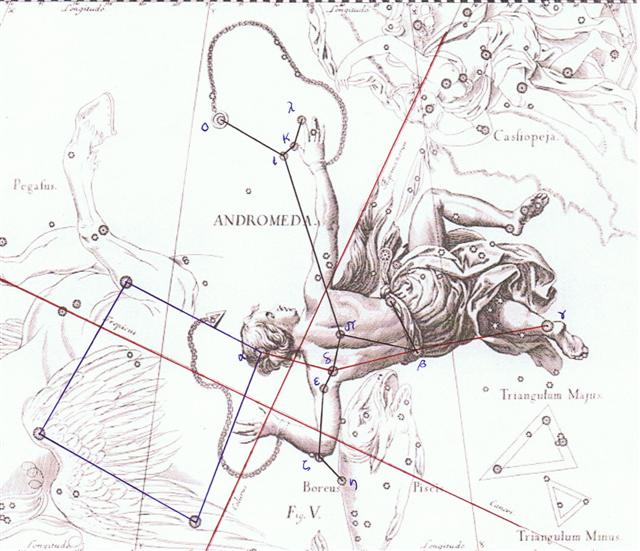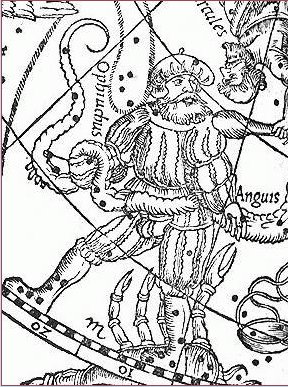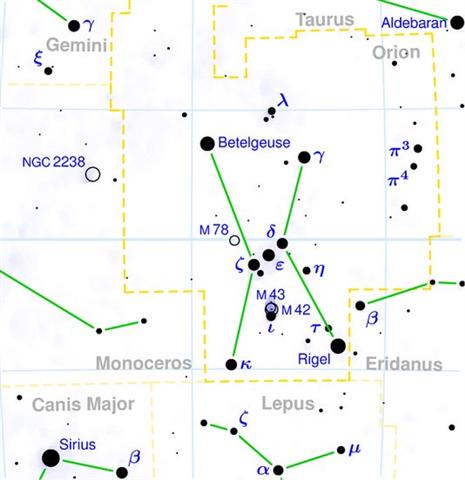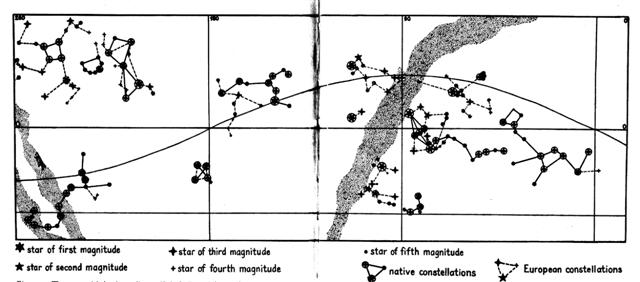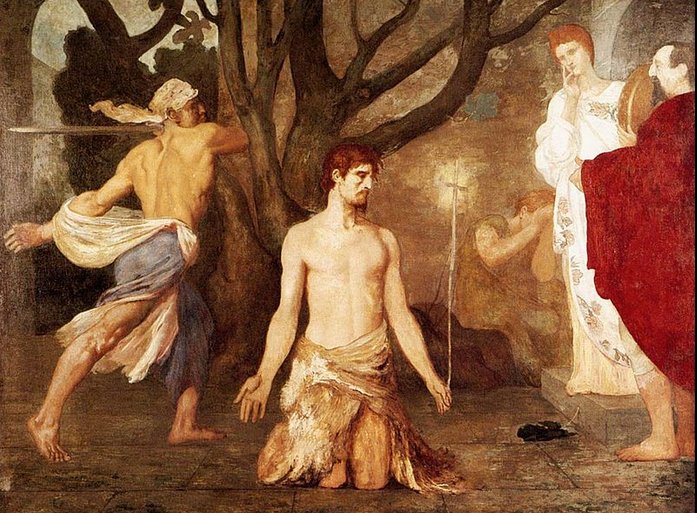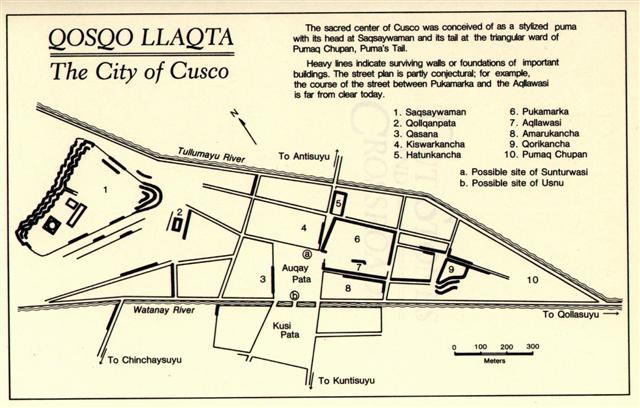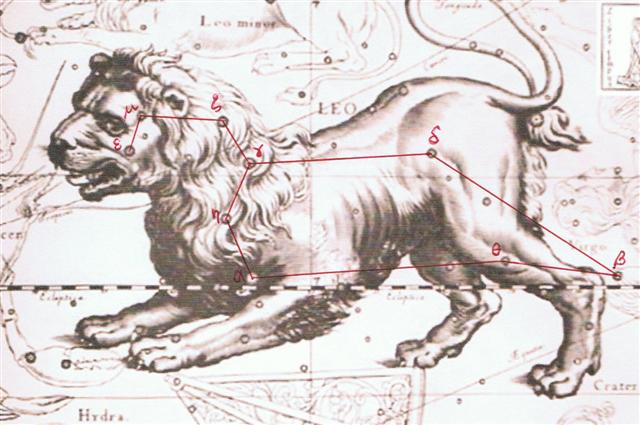246. Could not the ornaments on the shield in front, where Fenrir was bound in the background, represent the Pleiades? 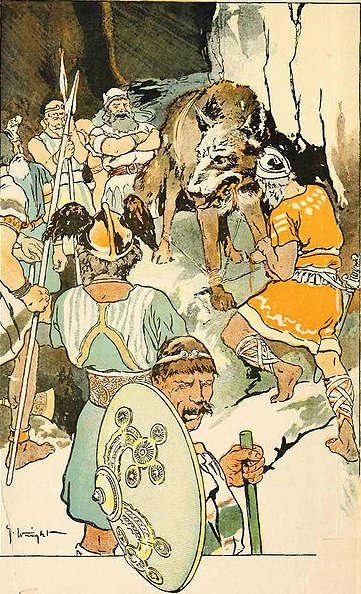 We can see 5 'stars' above and 4 below, as if they were emerging from a kind of cap at center left, and in the Pleiades cluster there are 9 stars with names: 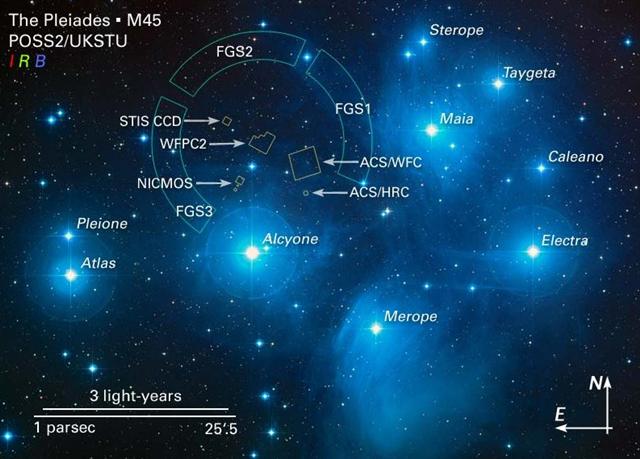 Once upon a time there was an old woman who owned a great potato field (mara) where she planted her potatoes in spring and harvested them in autumn. She was famous all around for her many varieties of wonderful potatoes, and she had enough of them to sell at the market place. She planted her potatoes 7 in a row, placing her foot in front of her as a measure from one potato to the next. Then she marked the place with a bean - which would also give nourishment to the surrounding potatoes. Next she changed variety and planted 7 more followed by another bean, and this was the pattern she followed until all her 214 varieties had been put down in their proper places. She had drawn a map which she followed and from where each sort of potato could be located at the proper time for its harvest. I was fashinated, when I happened to stumble on this Swedish TV program, because my 'once upon a time' was now and 214 (= 2 * 107) was surely no coincidence. She knew what she was doing. Let's therefore count: 214 * 7 (potatoes) + 213 (beans) = 1711. So what? Probably because 1711 = 59 * 29. But redundance ought to be a necessary feature when counting in time-space and we should therefore continue. 1711 could for instance also be regarded as 171 * 1 and her potato field could then be in memory of (to document) where Sirius had been at a very distant past. And 12 * 29½ = 354 counted from the Navel of the Horse (Sirrah) at the Full Moon in September 20 (*183) might have motivated placing the 3 unified 'king makers' (haka-ariki) at left in Ca13-11 - for the season of king making was here in the past, was decaying (mara), no longer in the lifegiving rays from the Sun.
The contours of the pair of earlier hakaariki glyphs in the C text were drawn stronger and especially the first little one, with the Sun at the Head of the Serpent Carrier, was very pronounced.
However, more to the point: Here the Full Moon was at Heka - corresponding to the central pyramid of Khafre (located at the String of Pearls, Al Nilam).
The present (at the time of rongorongo) right ascension day *171 at the heliacal stars which would have accompanied Sirius at the time when Itzam-Yeh was defeated - possibly with special regard to σ Leonis (*171.1) - which the old woman could have alluded to because of the sum of her 1498 potatoes and 213 beans,
had at the time of Gregory XIII risen 4 days earlier in the year, viz. at *171 - *4 = *167 (°September 4), and °September 8 would have been where the Full Moon reached the Chained Hand of Andromeda, *358 - *183 = *175 (= *350 / 2). ... Thus the regular old Roman year ended with Februarius 23 and it was 350 nights long, 25 fortnights. Then followed 5 extra nights, or as the Romans saw it 5 + 1 = 6 nights in order to include March 1, the first day of the new regular year ... Day 175 (June 24) was St John's Day which was 6 days before June 30 (with Sirius at the Sun). ... The evening of 23 June, St. John's Eve, is the eve of celebration before the Feast Day of Saint John the Baptist. The Gospel of Luke (Luke 1:36, 56-57) states that John was born about six months before Jesus; therefore, the feast of John the Baptist was fixed on 24 June, six months before Christmas Eve ...
... Midsummer is the flowering season of the oak, which is the tree of endurance and triumph, and like the ash is said to 'court the lightning flash'. Its roots are believed to extend as deep underground as its branches rise in the air - Virgil mentions this - which makes it emblematic of a god whose law runs both in Heaven and in the Underworld ... The month, which takes its name from Juppiter the oak-god, begins on June 10th and ends of July 7th. Midway comes St. John's Day, June 24th, the day on which the oak-king was sacrificially burned alive. The Celtic year was divided into two halves with the second half beginning in July, apparently after a seven-day wake, or funeral feast, in the oak-king's honour ... ... needfire ceremonies usually take place near the summer solstice (the Feast of St. John) ... but they occur in several other seasons as well. The summer date of the rite and its accompanying festival have to do, among other things, with fertility, as can can clearly be seen in a variant from the valley of the Moselle preserved for us by Jakob Grimm. Each household in the village was constrained to contribute a shock of straw to the nearby high place, Stromberg, where the males went at evening while the females went to a spring lower down on the slope. A huge wheel was wrapped with this straw. An axle run through the wheel served as the handles for those who were to guide it on its downward plunge. The mayor of a nearby town kindled the straw, for which office he was rewarded with a basketful of cherries. All the men kindled torches and some followed the burning orb as it was released downhill to shouts of joy. The women at the spring echoed these shouts as the wheel rushed by them. Often the fire went out of its own accord before it reached the river, but should the waters of the river extinguish it, an abundant vintage was forecast for that year ... If the regular year was considered (after the reform of Julius Caesar) to carry 364 regular days (= 350 + 14 = 358 + 6), then this was 10 days more than 12 * 29½, which fact might have motivated the position of hakaariki at the Full Moon in right ascension day *354 = half a year after heliacal Sirius. Sirius could not be observed in daytime and therefore its position in 29 December (at the time when Itzam-Yeh was defeated) corresponded to right ascension day *354 (March 10), because *283 (29 December) + *71 = *354 (March 10). Sometimes the right ascension difference *70 would have to be changed to *71 because the Sun calendar stretched only for 364 + 1 = 365 days while the right ascension year was approximately 365¼ days. However, line Ca13 continued in order to include also the 'Tail of Life' (Deneb-ola) where the Old Sun turned his face away and Virgo took over:
|
||||||||||||||||||||||||||||||||||||||||||||||||||||||||||||||||||||||||||||||||||||||||||||||||||||||||||||||||||||||||||||||||||||||||||||||||||||||||||||||||||||||||||||||||||




